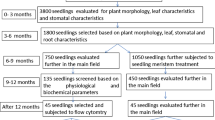Abstract
Calluna vulgaris is an important landscaping plant in Northern Europe. As C. vulgaris is the only species within the genus Calluna, the available gene-pool for breeding is rather narrow and phenotypic variation is limited. Hence, a breeding program for polyploids was set up in order to broaden phenotypic variation in this important ornamental crop. Therefor basic genetic characteristics of polyploid C. vulgaris were analyzed using the progeny of a spontaneously occurring tetraploid genotype. With the help of morphological and molecular marker analysis, it was determined that the autotetraploid plant probably arose from unreduced gametes resulting from first division restitution. Tetraploids displayed tetrasomic inheritance with free combination of homologous and homeologous chromosomes. Triploids were semi-fertile with a high rate of aneuploids in their progeny. As the so-called bud-blooming flower type is a trait of outstanding interest in breeding of C. vulgaris, a strategy for efficient breeding of triploid bud-bloomers was deduced.





Similar content being viewed by others
References
Acquaah G (2012) Polyploidy in plant breeding. In: Acquaah G (ed) Principles of plant genetics and breeding, 2nd edn. Wiley-Blackwell, Oxford, pp 452–469
Barringer (2007) Polyploidy and self-fertilization in flowering plants. Am J Bot 94:1527–1533
Behrend A, Borchert T, Spiller M, Hohe A (2013) AFLP-based genetic mapping of the “bud-flowering” trait in heather (Calluna vulgaris). BMC Genet 14:64
Borchert T, Gawenda I (2010) Development and application of high-throughput amplified fragment length polymorphism technique in Calluna vulgaris (Ericaceae). Electron J Biotechnol 13(2):8–9
Borchert T, Hohe A (2009) Identification of molecular markers for the flower type in the ornamental crop Calluna vulgaris. Euphytica 170:203–213
Borchert T, Hohe A (2010) Classification of flower types in Calluna vulgaris L. (Hull). Acta Hort 855:41–46
Borchert T, Krueger J, Hohe A (2008) Implementation of a model for identifying essentially derived varieties in vegetatively propagated Calluna vulgaris varieties. BMC Genet 9:56
Borchert T, Eckhardt K, Fuchs J, Krüger K, Hohe A (2009) ‘Who’s who’ in different flower types of Calluna vulgaris (Ericaceae): morphological and molecular analyses of flower organ identity. BMC Plant Biol 9:148
Borchert T, Behrend A, Hohe A (2012) On the genetics of the ‘bud-flowering’ trait in the ornamental crop Calluna vulgaris. Acta Hort 930:111–117
Dweikat IM, Lyrene PM (1988) Production and viability of unreduced gametes in triploid interspecific blueberry hybrids. Theor Appl Genet 76:555–559
Köhler C, Mittelsten Scheid O, Erilova A (2010) The impact of the triploid block on the origin and evolution of polyploid plants. Trends Genet 26:142–148
Lyrene PM, Vorsa N, Ballington JR (2003) Polyploidy and sexual polyploidization in the genus Vaccinium. Euphytica 133:27–36
Mahy G, Jacquemart AL (1998) Mating system of Calluna vulgaris: self-sterility and outcrossing estimations. Can J Bot 76:37–42
Ortiz R, Vorsa N, Bruederle LP, Laverty T (1992a) Occurrence of unreduced pollen in diploid blueberry species Vaccinium sect. Cyanococcus. Theor Appl Genet 85:55–60
Ortiz R, Bruederle LP, Laverty T, Vorsa N (1992b) The origin of polyploids via 2n gametes in Vaccinium section Cyanococcus. Euphytica 61:241–246
Ramsey J, Schemske DW (1998) Pathways, mechanisms, and rates of polyploid formation in flowering plants. Annu Rev Ecol Syst 29:467–501
Rounsaville TJ, Touchell DH, Ranney TG (2011) Fertility and reproductive pathways in diploid and triploid Miscanthus sinensis. HortScience 46:1353–1357
Trueblood CE, Ranney TG, Lynch NP, Neal JC, Olsen RT (2010) Evaluating fertility of triploid clones of Hypericum androsaemum L. for use as non-invasive landscape plants. HortScience 45:1026–1028
Vorsa N, Ballington JR (1991) Fertility of triploid highbush blueberry. J Am Soc Hortic Sci 116:336–341
Vos P, Hogers R, Bleeker M, Reijans M, van de Lee T, Hornes M, Friters A, Pot J, Paleman J, Kuiper M, Zabeau M (1995) AFLP: a new technique for DNA fingerprinting. Nucleic Acids Res 23:4407–4414
Author information
Authors and Affiliations
Corresponding author
Rights and permissions
About this article
Cite this article
Przybyla, A., Behrend, A., Bornhake, C. et al. Breeding of polyploid heather (Calluna vulgaris). Euphytica 199, 273–282 (2014). https://doi.org/10.1007/s10681-014-1117-1
Received:
Accepted:
Published:
Issue Date:
DOI: https://doi.org/10.1007/s10681-014-1117-1




